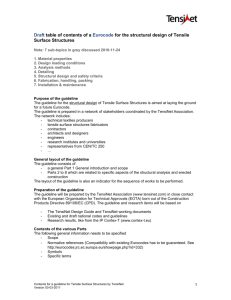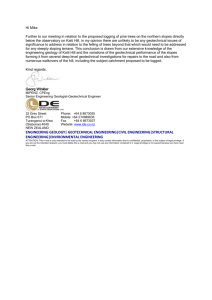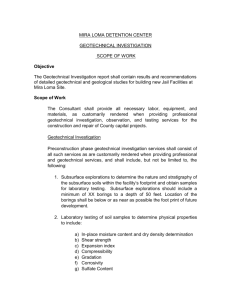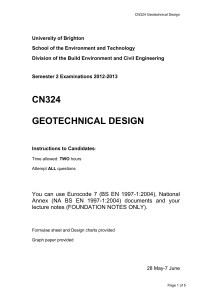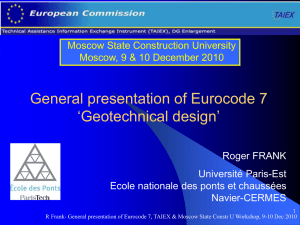the BDA Newsletter extracts - British Drilling Association
advertisement
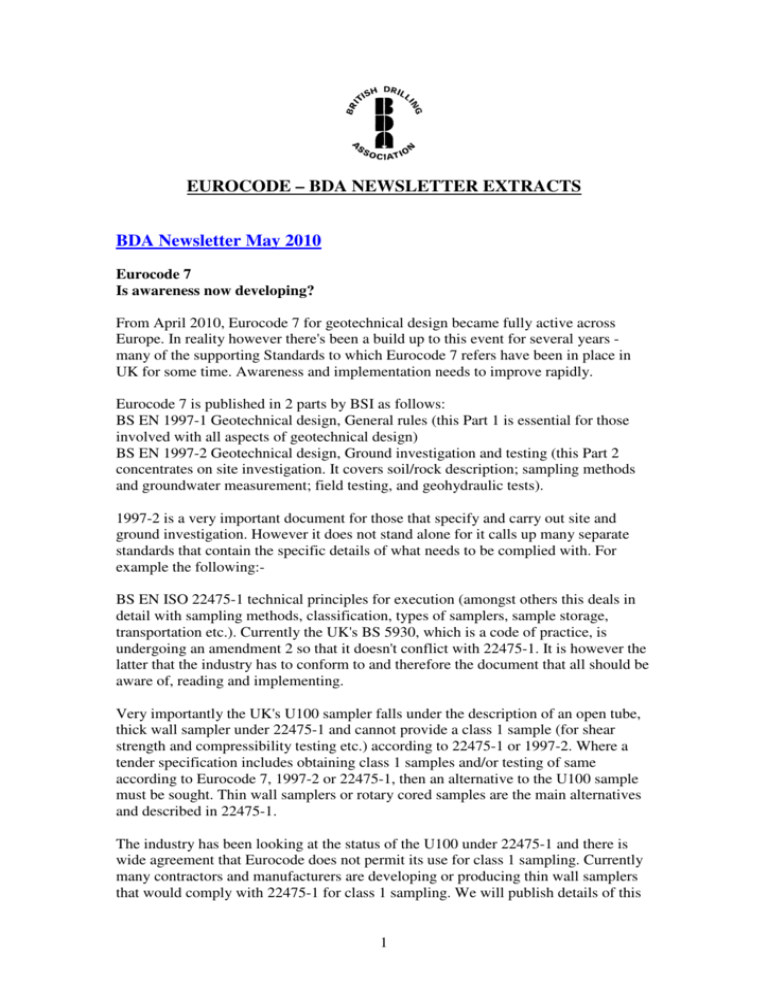
EUROCODE – BDA NEWSLETTER EXTRACTS BDA Newsletter May 2010 Eurocode 7 Is awareness now developing? From April 2010, Eurocode 7 for geotechnical design became fully active across Europe. In reality however there's been a build up to this event for several years many of the supporting Standards to which Eurocode 7 refers have been in place in UK for some time. Awareness and implementation needs to improve rapidly. Eurocode 7 is published in 2 parts by BSI as follows: BS EN 1997-1 Geotechnical design, General rules (this Part 1 is essential for those involved with all aspects of geotechnical design) BS EN 1997-2 Geotechnical design, Ground investigation and testing (this Part 2 concentrates on site investigation. It covers soil/rock description; sampling methods and groundwater measurement; field testing, and geohydraulic tests). 1997-2 is a very important document for those that specify and carry out site and ground investigation. However it does not stand alone for it calls up many separate standards that contain the specific details of what needs to be complied with. For example the following:BS EN ISO 22475-1 technical principles for execution (amongst others this deals in detail with sampling methods, classification, types of samplers, sample storage, transportation etc.). Currently the UK's BS 5930, which is a code of practice, is undergoing an amendment 2 so that it doesn't conflict with 22475-1. It is however the latter that the industry has to conform to and therefore the document that all should be aware of, reading and implementing. Very importantly the UK's U100 sampler falls under the description of an open tube, thick wall sampler under 22475-1 and cannot provide a class 1 sample (for shear strength and compressibility testing etc.) according to 22475-1 or 1997-2. Where a tender specification includes obtaining class 1 samples and/or testing of same according to Eurocode 7, 1997-2 or 22475-1, then an alternative to the U100 sample must be sought. Thin wall samplers or rotary cored samples are the main alternatives and described in 22475-1. The industry has been looking at the status of the U100 under 22475-1 and there is wide agreement that Eurocode does not permit its use for class 1 sampling. Currently many contractors and manufacturers are developing or producing thin wall samplers that would comply with 22475-1 for class 1 sampling. We will publish details of this 1 when further information reaches us and there is wider consensus and acceptance of what's been developed. Members should consult the technical press; manufacturers & suppliers, and look out for publication of BS 5930 Amendment 2 on this subject. Another aspect of Eurocode 7 is in-situ testing and in particular the Standard Penetration Test (SPT). Since 2005 there has been a new standard for SPT, namely BS EN ISO 22476-3 2005 which forms part of Eurocode. 22476-3 is available from BSI (http://shop.bsigroup.com) at a current cost of £124 (£62 to BSI members). It contains details of how the test should be performed; requirements for hammer certification etc. Copyright issues do not permit us to publish or distribute its contents (this applies to all BSI publications). BDA members should obtain a copy if they're specifying or carrying out SPT testing as the old standard in BS 1377 has been withdrawn for several years. Amendment 2 to BS 5930 to be published later this year will also make this clear. Is awareness of Eurocode 7 now developing? Certainly amongst larger organisations there has been attention paid to the introduction of Eurocode. With greater resources and liabilities you'd expect this. Overall however the UK has been slow to react and now it's time to catch up for many. Training courses do exist and the BDA can advise where these can be obtained. The first step for many must be to become familiar with what's in Eurocode and its relevant Standards. It is a time of change and each company has to assess the impact on its business. BDA Newsletter December 2009 Eurocode 7 will be here in March 2010 What's it all about? Those that are unaware of Eurocode 7 need to rapidly catch up. Those who have heard of it but are unaware of what impact it will make also need to develop full awareness. Those who are fully prepared for it are unfortunately few and far between. For the majority, Eurocode 7 is not understood and yet within a couple of months it will have to be followed. BDA Ground Investigation members particularly have to take note of it. A full description of Eurocode 7 appeared in the August 2008 Newsletter so it is not intended in this article to repeat all that appeared there. Members can contact the BDA office for a back copy. Put simply, Eurocode 7: Geotechnical Design is the seventh component of European Community Rules and Standards for construction which becomes "legal" in March 2010. Eurocode 7 deals with rules / standards for geotechnical matters including ground investigation and testing (but also piling, grouting, anchoring etc.). Eurocode 7 is published in 2 parts by BSI as follows: BS EN 1997-1 2004 Geotechnical design, General rules (we shall call it 1997 Part 1) BS EN 1997-2 2007 Geotechnical design, Ground investigation and testing (we shall call it 1997 Part 2) 2 1997-2 Part 2 covers soil/rock description; sampling methods and groundwater measurement; field testing, and geohydraulic tests. It's essential for anyone specifying or carrying out ground investigation to be familiar with this document. Life would be simple if it was only one document that needed consulting. 1997-2 Part 2 refers to 45 other documents (Standards or Technical Specifications) - in these lie the specific details of what needs to be complied with. For example one of these is SPT testing (BS EN ISO 22476-3) - there are others for each specific in-situ test (including 8 for pile, anchor and nail testing). Concentrating on what a ground investigation contractor immediately needs to become familiar with, in addition to 1997-2 Part 2, are the following: BS EN ISO 22475-1 technical principles for execution BS EN ISO 14688 (2 standards on soil) BS EN ISO 14689 (rock) BS EN ISO 22476-3 (SPT testing) The above can be purchased from BSI (www.bsigroup.com or http://shop.bsigroup.com) Note: You may also need other Standards if carrying out other activity e.g. dynamic probing) It's impossible to list or describe all that Eurocode entails or go further in providing guidance as to how to implement. It's a big topic. The BDA welcomes however any questions you may have, and will endeavour to provide information or point you in the right direction for further clarification, training etc. BDA Newsletter August 2008 EUROCODE 7 IS COMING Who's prepared? What's it's all about? Many will have heard of Eurocode 7: Geotechnical Design. Some may be familiar with its contents but very few know much more than that. But even now in certain cases, and by March 2010 at the latest, it affects anyone engaged in geotechnical work - be it ground investigation, geotechnical processes etc. It's time for everyone to get up to speed, look at the detail and plan how to meet the requirements. The industry will have to work to Eurocode standards - it can't be avoided. The history of Eurocode goes back to 1975 when the European Community initiated a programme to produce common Rules and Standards for construction. These Rules and Standards when produced would override and replace any existing standards in a Member State. Any conflicting Member State standards have to be withdrawn no later than March 2010. During the 1990s all 9 Eurocode parts were produced and issued covering different types of structures and geotechnical works. Each Eurocode part was to be supported by a suite of new individual Standards that were listed and mentioned in the text of each Eurocode part. It is important to note that while Eurocode itself does not become a "legal" Standard until March 2010, many of the individual supporting Standards are 3 operational now. For example there is already a new Standard for SPT (Standard Penetration Testing) issued in 2005. Eurocode 7: Geotechnical Design is part 7 of Eurocode and it's the one that should have our attention. It was published in UK by BSI in 2 parts: BS EN 1997-1 2004 Geotechnical design, General rules BS EN 1997-2 2007 Geotechnical design, Ground Investigation and testing BS EN 1997-1 (we shall call it 1997 Part 1) calls up 12 individual standards on piling, anchors, grouting etc. BS EN 1997-2 (we shall call it 1997 Part 2) calls up 45 individual standards or technical specifications. We shall concentrate here on 1997 Part 2 to illustrate both the complexity and difficulties for our ground investigation members. This is not to ignore that anyone in piling, grouting, anchoring etc. should also be aware that this Part also touches on them. The 45 individual standards and technical specifications under 1997 Part 2 are what matters for those that carry out ground investigation field works and/or reporting. They do include laboratory testing (12 technical specifications all beginning with 17892) but this is not mandatory in UK at this time. Of the remaining 33 standards, 8 are to do with pile, anchor and nail testing (all beginning with 22477) - none of these are published yet. That leaves a further 25 Standards which are grouped as follows: 14688 Identification and classification of soil (2 standards) 14689 Identification and classification of rock (1 standard) The above have been published as BS EN ISO standards from 2002 to 2004. They are operational now. The UK standard covering this area is BS 5930 1999 (Section 6) and it's been republished in December 2007 to remove any conflict with the above new standards. Its new title is BS 5930: 1999 Amendment 1. This amendment is only to Section 6 - all other sections remain as before (at least for the time being!). Here we have the first UK compromise. New UK / European standards have been published under Eurocode, which people should read and adhere to, but people can still use BS 5930 (as amended) because it doesn't conflict. It was felt that BS 5930 was too good to throw away as it contained a lot of useful information. Whatever, BDA members should ideally have copies of the three 14688 standards and the republished 5930. 22475 Sampling methods and groundwater measurement (3 standards) Part 1, Technical principles for execution, (BS EN ISO 22475-1: 2006) was published in 2006. It is a most important document for anyone involved with the taking of samples in the field. Currently a BDA working group is comparing it to what's written in BS 5930. This work is being done on behalf of BSI. The BDA group's brief is to inspect 5930 for any conflicts. BSI will then decide what to do about 5930. One possibility is that there'll be a 5930 Amendment 2. 4 Part 2, Qualification criteria for enterprises and personnel, is being published shortly. Part 3, Conformity assessment of enterprises and personnel by third party, is being published shortly. This contains the principle that drilling operatives shall be audited on a regular basis by an independent body. The BDA AUDIT scheme will satisfy this requirement. 22476 Field testing (13 standards and technical specifications) This suite of standards and technical specifications covers the following testing: Electrical cone and piezocone; Dynamic probing; SPT; Menard pressuremeter; Flexible dilatometer; Self boring pressure meter; Borehole jacking, Full displacement pressuremeter; Field vane; Weight sounding; Flat dilatometer; Mechanical cone, and Plate loading. Most are still under preparation but due to appear over the next 12 months. Weight sounding test and Flat dilatometer have been published as technical specifications (and therefore not mandatory in UK). However the following two have been published and should already be being used: BS EN ISO 22476-2 Dynamic probing: 2005 BS EN ISO 22476-3 Standard penetration test: 2005 The parts of BS 1377 that refer to the above two tests have already been withdrawn. Of particular change is the new requirement that all SPT hammers shall be tested for their energy efficiency every six months. This means that it is no longer sufficient for the results of an SPT test to stand alone without a correction factor being applied (derived from the energy efficiency of the particular hammer that was used). All SPT hammers will have to be specially tested. The equipment for such testing is believed to be made in the USA and several companies are in the process of importing it. One company will be offering a testing service for any contractor unable to afford the equipment. 22282 Geohydraulic tests (6 standards) This suite of test standards covers Water permeability (without packer); Water pressure in rock; Pumping; Infiltrometer, and Closed packer. None are yet published but will be over the forthcoming months. It is of prime importance that all geotechnical enterprises, whether acting as consultant, contractor or sub-contractor, familiarise themselves with what's happening. There will be a period of confusing specifications appearing in tender documents - some referring to 5930 & 1377; some referring to the new standards above, and some carrying a mixture of both old and new. It's a recipe for disaster if a blind eye is turned to Eurocode and its standards. 5
